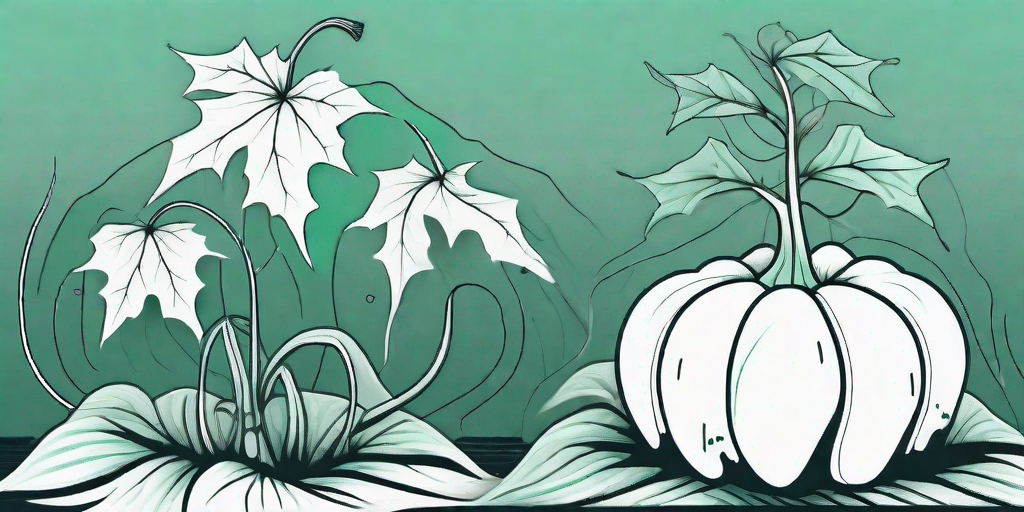
Welcome, dear gardeners and pumpkin enthusiasts! If you've ever been haunted by the sight of ghostly white leaves on your beloved pumpkin plants, you're not alone. This spooky phenomenon is more common than you might think. But fear not! We're here to demystify this pale predicament and help you bring your pumpkins back from the other side. So, buckle up and get ready to banish those spectral leaves once and for all!
Understanding the Ghostly White Leaves
Before we dive into the solution, let's first understand the problem. White leaves on pumpkin plants are often a sign of powdery mildew - a common fungal disease that affects a wide range of plants. It's like the common cold for plants, but a bit more eerie. The fungus, which thrives in humid conditions, covers the leaves in a white, powdery substance, hence the name.
But wait, there's more! Powdery mildew doesn't just turn your pumpkin leaves into ghostly apparitions. It can also stunt growth, reduce yield, and in severe cases, cause the plant to die. Now that's a real Halloween horror story!
Identifying Powdery Mildew
So, how can you tell if your pumpkin plant is suffering from powdery mildew? Well, the first sign is usually the appearance of white or grey patches on the leaves. These patches may start small but can quickly cover the entire leaf surface.
As the disease progresses, the leaves may start to curl and turn yellow. In severe cases, the leaves may even become distorted and die off. If left untreated, powdery mildew can spread to the stems and fruits, causing further damage.
Fixing the White Foliage: A Step-by-Step Guide
Now that we've identified the culprit, it's time to take action. Here's a step-by-step guide to help you banish the powdery mildew and restore your pumpkin plants to their former glory.
Step 1: Remove Infected Leaves
The first step in your ghost-busting mission is to remove the infected leaves. This will help to reduce the spread of the fungus to other parts of the plant. Remember to dispose of the leaves properly and not to compost them, as this can spread the disease.
When removing the leaves, be sure to wear gloves and wash your hands afterwards to prevent the spread of the fungus. It's also a good idea to disinfect your pruning shears after use.
Step 2: Apply a Fungicide
Once you've removed the infected leaves, it's time to apply a fungicide. There are many different types available, so choose one that's suitable for treating powdery mildew on pumpkin plants.
Follow the instructions on the product label for the best results. Remember, it's always better to prevent than to cure, so consider applying a fungicide as a preventative measure in the future.
Step 3: Improve Air Circulation
Powdery mildew thrives in humid conditions, so improving air circulation can help to prevent the disease. This can be achieved by spacing your plants properly and pruning them regularly to allow air to flow freely.
Remember, a well-ventilated pumpkin patch is a happy pumpkin patch!
Preventing Future Outbreaks
Now that you've banished the ghostly white leaves, you'll want to prevent future outbreaks. Here are some tips to help you keep powdery mildew at bay.
Choose Resistant Varieties
Some pumpkin varieties are more resistant to powdery mildew than others. So, when choosing your seeds, look for varieties that are labelled as resistant. This can help to reduce the risk of an outbreak.
Water Wisely
Watering your plants properly can also help to prevent powdery mildew. The fungus thrives in humid conditions, so avoid watering your plants from above. Instead, water at the base of the plant to keep the leaves dry.
Rotate Your Crops
Rotating your crops can also help to prevent the spread of diseases like powdery mildew. By planting your pumpkins in a different area each year, you can help to break the disease cycle and reduce the risk of an outbreak.
Frequently Asked Questions
- Can powdery mildew kill my pumpkin plants?
Yes, if left untreated, powdery mildew can cause severe damage and even kill your pumpkin plants. However, if caught early and treated properly, your plants can recover.
- Can I eat pumpkins that have been affected by powdery mildew?
Yes, the fruits of plants affected by powdery mildew are safe to eat. However, the disease can affect the quality and yield of the fruits.
- Is powdery mildew contagious?
Yes, powdery mildew can spread from plant to plant, especially in close quarters. That's why it's important to remove infected leaves and apply a fungicide as soon as you notice the disease.
Conclusion
There you have it, folks! With this guide, you're now equipped to banish those ghostly white leaves and restore your pumpkin plants to their vibrant, healthy selves. Remember, prevention is key, so keep an eye out for early signs of powdery mildew and act swiftly to keep your pumpkin patch in tip-top shape. Happy gardening!











